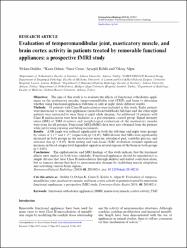| dc.contributor.author | Özdiler, Orhan | |
| dc.contributor.author | Orhan, Kaan | |
| dc.contributor.author | Cesur, Emre | |
| dc.contributor.author | Köklü, Ayşegül | |
| dc.contributor.author | Algın, Oktay | |
| dc.date.accessioned | 2019-12-26T07:24:58Z | |
| dc.date.available | 2019-12-26T07:24:58Z | |
| dc.date.issued | 2019 | en_US |
| dc.identifier.citation | Özdiler, O., Orhan, K., Cesur, E., Köklü, A. ve Algın, O. (2019). Evaluation of temporomandibular joint, masticatory muscle, and brain cortex activity in patients treated by removable functional appliances: A prospective fMRI study. Dentomaxillofacial Radiology, 48(7). http://doi.org/10.1097/10.1259/dmfr.20190216 | en_US |
| dc.identifier.issn | 0250-832X | |
| dc.identifier.uri | http://doi.org/10.1097/10.1259/dmfr.20190216 | |
| dc.identifier.uri | https://hdl.handle.net/20.500.12511/4712 | |
| dc.description.abstract | Objectives: The aim of this study is to evaluate the effects of functional orthodontic appliances on the masticatory muscles, temporomandibular joint (TMJ), and brain to determine whether using functional appliances full-time or only at night yields different results. Methods: 16 patients with Class II malocclusion were included in this study. Eight patients were instructed to wear their appliances (monoblock/twinblock) full-time and the other eight patients were instructed to wear them at night while sleeping. An additional 10 patients with Class II malocclusion were later included as a pre-treatment control group. Signal intensity ratios (SIR) of TMJ structures and morphological evaluations of the masticatory muscles were done for all patients. Functional MRI (fMRI) data were also obtained from the patients while performing chewing and biting movements. Results: ANB angle was reduced significantly in both the full-time and night wear groups, by values of 1.17° and 1.35°, respectively (p < 0.05). MRI showed that SIRs were significantly increased in both groups in the masticatory muscles, retrodiscal pad, condylar process, and articular disc (p < 0.05). Both resting and task-based fMRI evaluation revealed significant increases in blood oxygen level dependent signals in several regions of the brain in both groups (p < 0.05). Conclusions: The cephalometric and MRI findings of this study indicate that the treatment effects were similar for both wear schedules. Functional appliances should be regarded not as simple devices that treat Class II malocclusion through skeletal and dental correction alone, but as exercise devices that lead to neuromuscular changes by facilitating muscle adaptation and activating various brain regions. | en_US |
| dc.description.sponsorship | Ankara University Scientific Research Projects Center (BAP) | en_US |
| dc.language.iso | eng | en_US |
| dc.publisher | British Institute of Radiology | en_US |
| dc.rights | info:eu-repo/semantics/openAccess | en_US |
| dc.subject | Cortex Activity | en_US |
| dc.subject | FMRI | en_US |
| dc.subject | Functional Orthodontic Appliances | en_US |
| dc.subject | Masticatory Muscle | en_US |
| dc.subject | TMJ | en_US |
| dc.title | Evaluation of temporomandibular joint, masticatory muscle, and brain cortex activity in patients treated by removable functional appliances: A prospective fMRI study | en_US |
| dc.type | article | en_US |
| dc.relation.ispartof | Dentomaxillofacial Radiology | en_US |
| dc.department | İstanbul Medipol Üniversitesi, Diş Hekimliği Fakültesi, Ortodonti Ana Bilim Dalı | en_US |
| dc.authorid | 0000-0003-0176-8970 | en_US |
| dc.identifier.volume | 48 | en_US |
| dc.identifier.issue | 7 | en_US |
| dc.relation.publicationcategory | Makale - Uluslararası Hakemli Dergi - Kurum Öğretim Elemanı | en_US |
| dc.identifier.doi | 10.1259/dmfr.20190216 | en_US |
| dc.identifier.wosquality | Q3 | en_US |
| dc.identifier.scopusquality | Q1 | en_US |


















